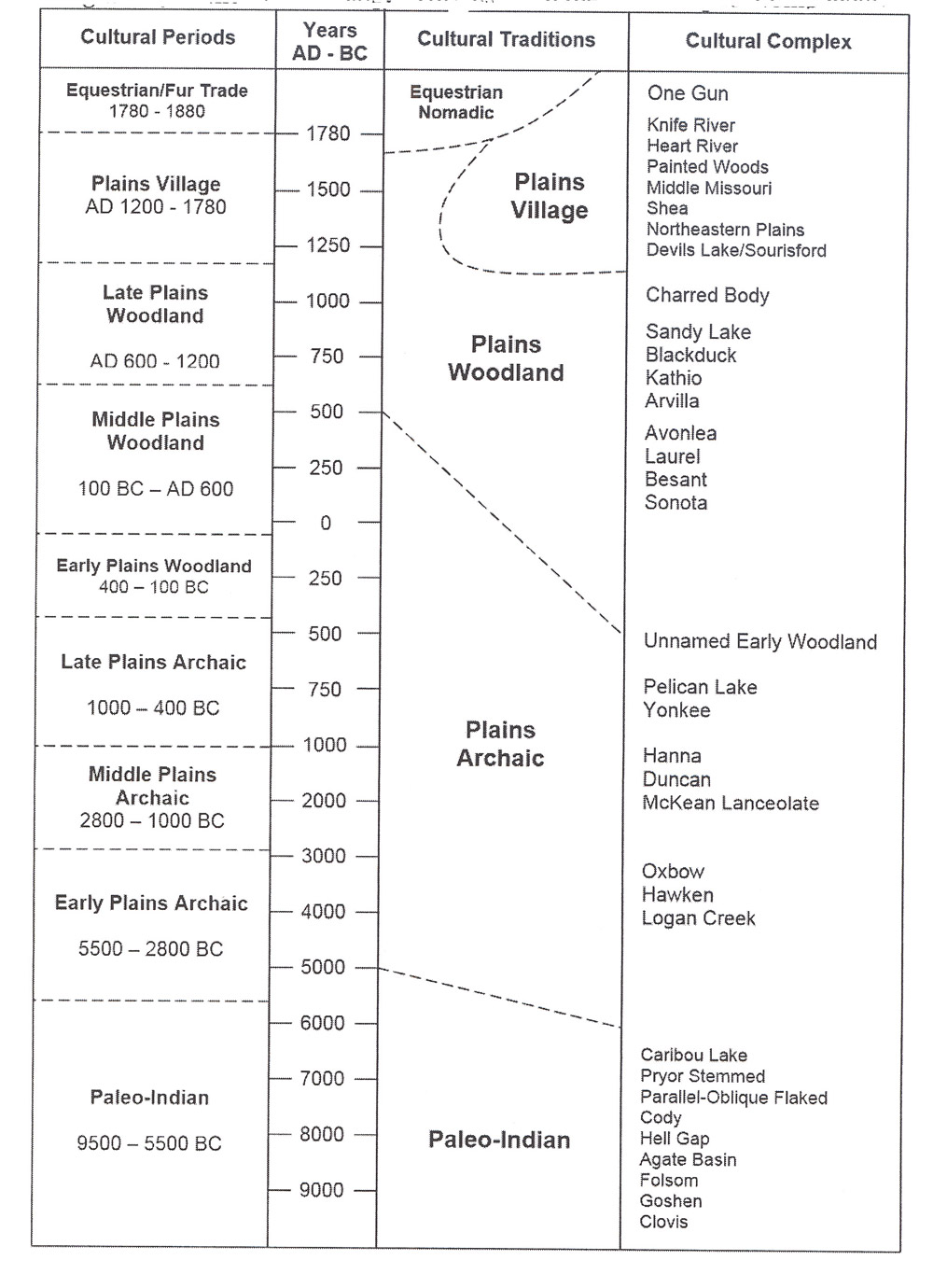Because we know so little about the People who lived in North Dakota in the ancient past, archaeologists have created a system for identifying groups of People by the tools they made. (See Image 3.)
The most ancient group of People, those who lived here from about 10,000 B.C. to about 5,500 B.C., were called Paleo-Indians (paleo means “very old”). The People who made Clovis and Folsom projectile points were Paleo-Indians.

The Plains Archaic People were descended from the Paleo-Indians, but they lived differently and made different tools, so they have a different name. The People of the Plains Archaic Period lived from about 5,500 B.C. to about 400 A.D. This time period is often divided into Early, Middle, and Late Plains Archaic. As far as we know, the People of the Plains Archaic Period were nomadic. They followed the herds, sought plant foods in season, and traveled to places where they could mine the right kinds of stones to make into projectile points and other tools. The Plains Archaic People used atlatls.
From about 400 B.C. to about 600 A.D., the People of the Plains Woodland cultures lived in North Dakota. We cannot be sure that the People of the Plains Archaic cultures stayed in this region and adapted the Plains Woodland culture. The Woodland cultures might have migrated here from other places. Their cultures were similar to the culture of People who lived in the forests to the east of the Great Plains. To distinguish them from Woodlands cultures of the forests, we call them Plains Woodland. We do know that some of them lived in houses made of wooden posts covered with hides (similar to tipis) or grasses and tree bark. The People who lived at the Naze Village on the James River were of the Woodland tradition. While the Woodland cultures were nomadic, it is possible that they also cultivated wild plants for food. In addition, they might have traded with People who were raising crops such as corn.
There are a couple of significant cultural traditions that identify the Woodland culture. One Woodland tradition was the way they buried their dead. Instead of placing the remains of someone on a platform or under rock, they buried their dead in the ground and constructed a mound of earth over the grave. Sometimes the mounds were shaped like animals. These were called effigy (EFF-ih-gee) mounds. People used some of these mounds for 1,000 years or more. Another identifying characteristic was the development of pottery. People of the Plains Woodland tradition made clay pots which they used to cook and carry or store water. These large pots (as much as two feet tall and one foot across) could be placed in a fire to heat food or water.
The Plains Woodland cultures are also divided into three groups: the Early, Middle, and Late Plains Woodland. The Late Plains Woodland era began around 600 A.D. and extended to about 1200 A.D. Some parts of the culture might have lasted until the mid-19th century.
After 1200 A.D., there was a distinct division in Plains cultures. Some Peoples maintained a nomadic lifestyle. They hunted and followed the great herds of bison. They lived in tipis that were ideal for their mobile lifestyle. Their travels allowed them to engage in trade with many other Peoples. Through trade, they were able to obtain everything they needed for a comfortable life. The nomadic lifestyle was well-adapted to life on the Great Plains.
The other major cultural group adopted the Plains Village tradition (1200 to 1885 A.D.). These People built and lived in permanent villages. The Plains Village culture appears to have evolved directly from earlier Woodland cultures. Over two or three hundred years, the People who became the Mandans moved from the forests of Minnesota to the Plains of North Dakota. They made their houses with wooden beams covered with grass and dirt.
The Mandans and the Hidatsas who later joined the Mandans adapted the Plains Village tradition. They lived along the Missouri River where they cultivated corn and other vegetables in gardens. Surpluses of these crops (more than a family needed) were traded to other tribes for other things they needed. The Mandans and Hidatsas moved seasonally. Their summer villages were on the uplands above the river. Their winter villages were located along the river in the trees that lined the riverbanks. The summer villages were permanent, but the winter villages were occupied for only a year or two. Spring floods destroyed the winter villages.
Why is this important? While we know that there were different cultures living in North Dakota in the past, we know very little about those who lived here before 1200 A.D. We don’t know what they called themselves, what language they spoke, or what their relationships with other groups were like. We do know that several cultures lived in North Dakota over a period of 13,000 years or more. These cultures can be distinguished by the way they made tools, the kind of economies they pursued (farming or hunting/gathering), and by the way they made their houses. The archaeological system for organizing the present knowledge of ancient Peoples helps us to understand how different cultures came to be and how they changed and adapted to new conditions over time.


